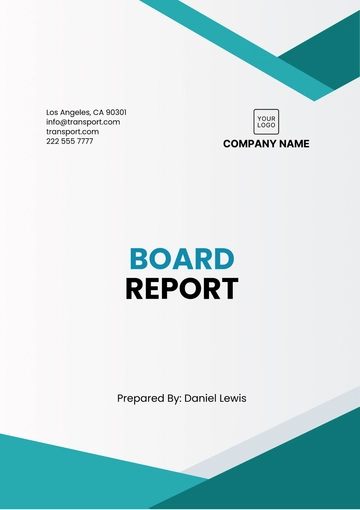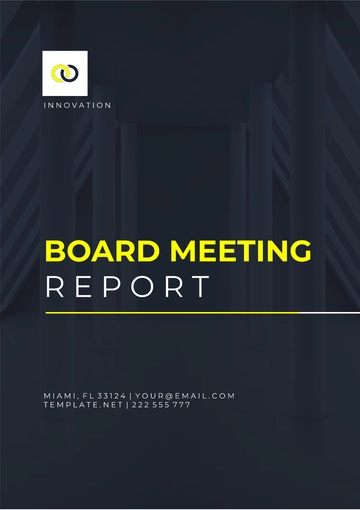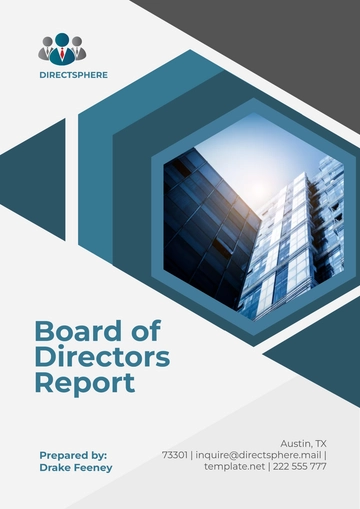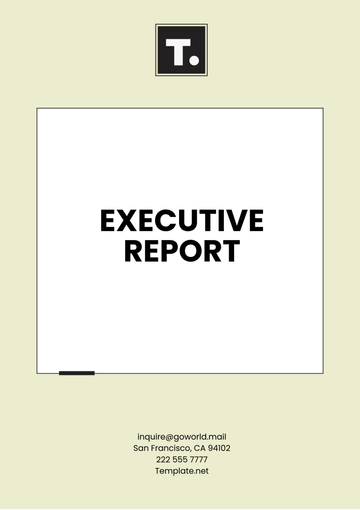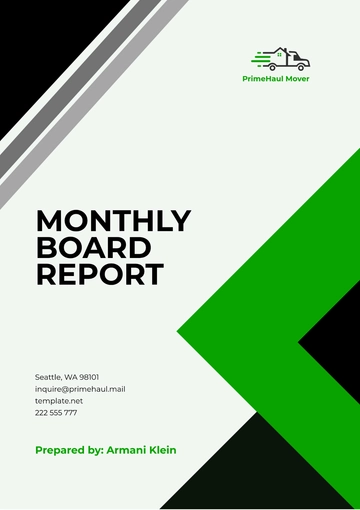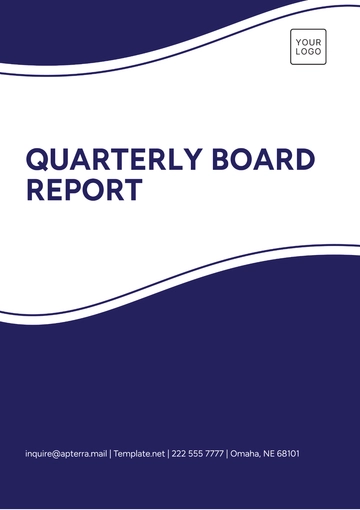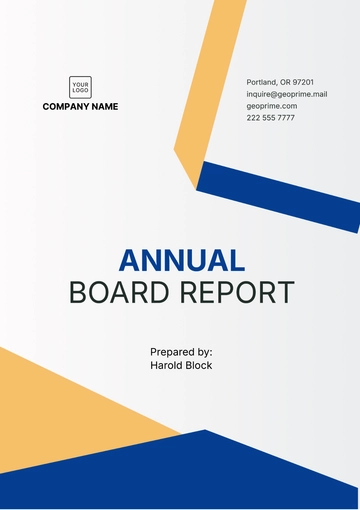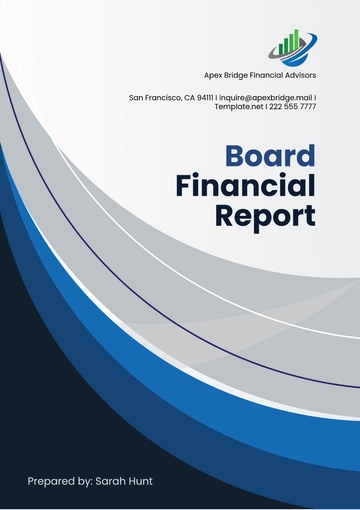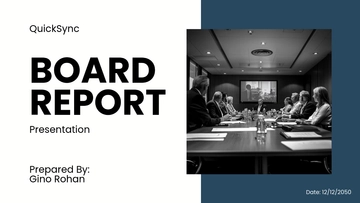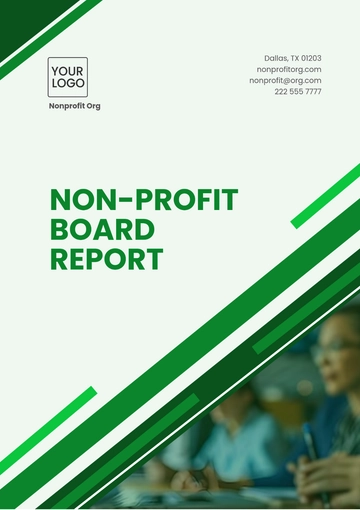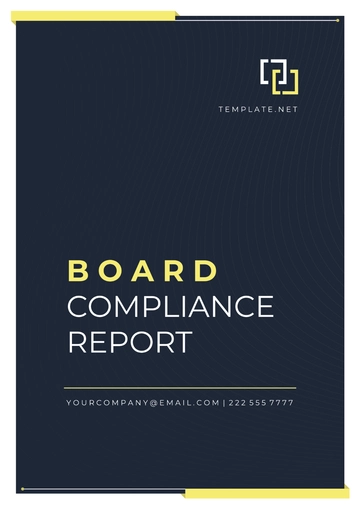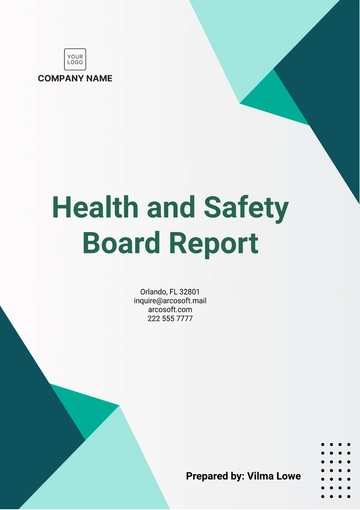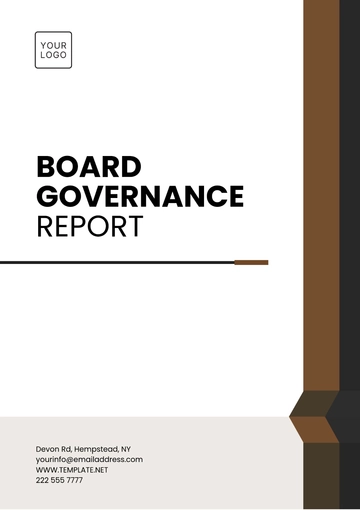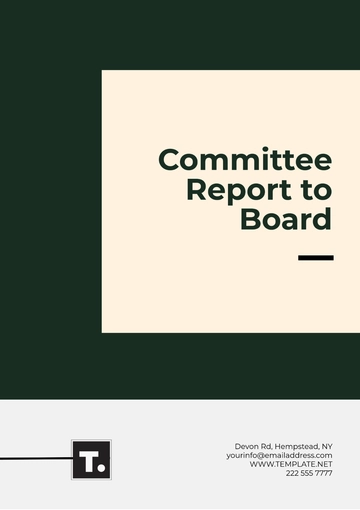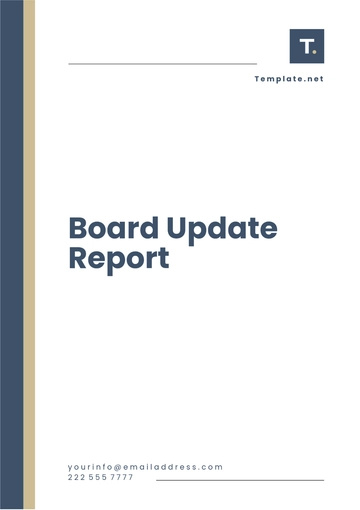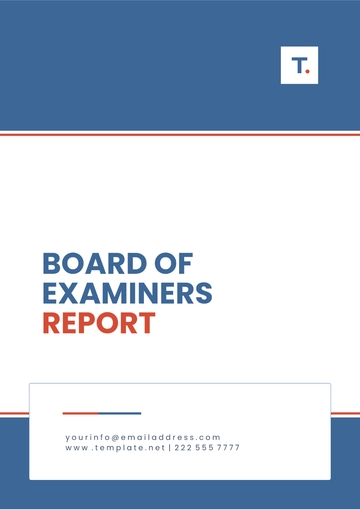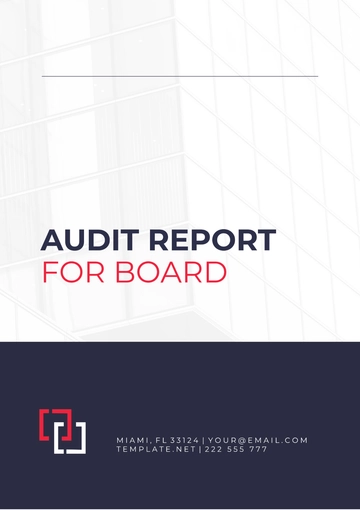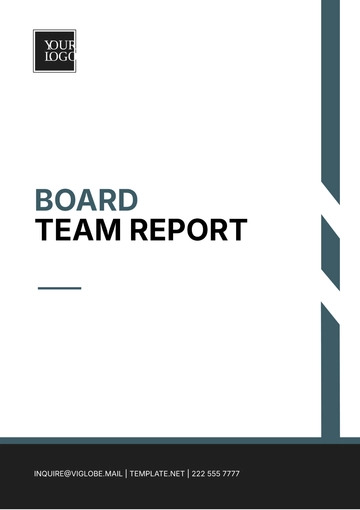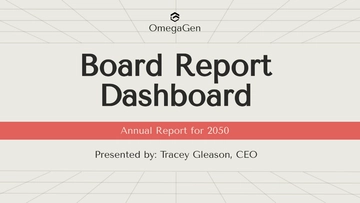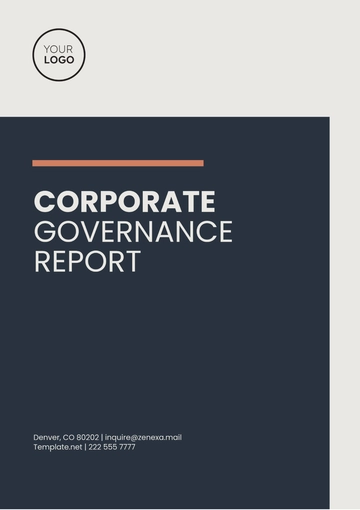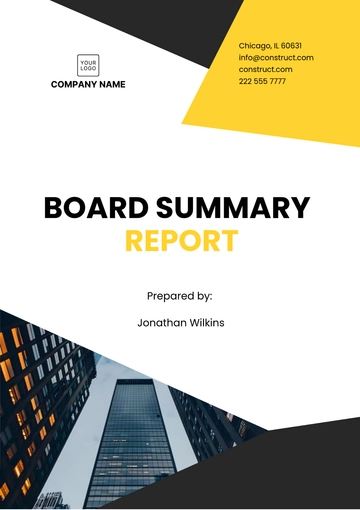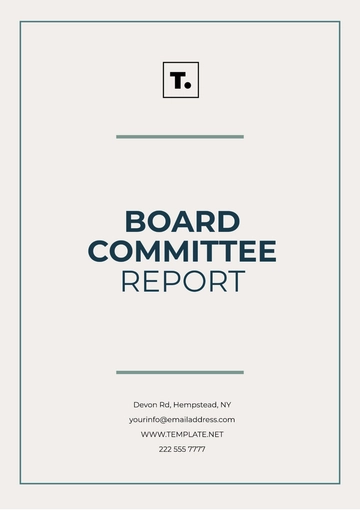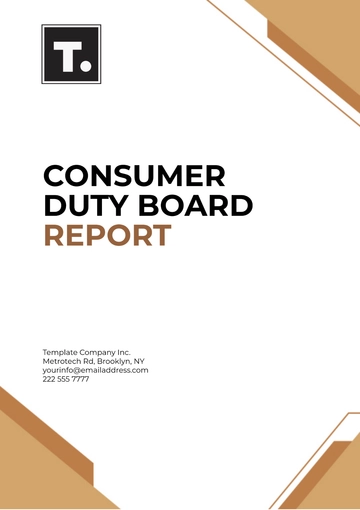Free Car Rental Board Report

I. Executive Summary
This report provides an update on the current operations, strategic initiatives, financial performance, and key developments of [Your Company Name]. It outlines our progress towards achieving business objectives and highlights areas of focus for future growth and sustainability.
II. Operational Overview
Our operational overview underscores [Your Company Name]'s commitment to maintaining a robust fleet, enhancing customer service excellence, and integrating advanced technology to optimize operations and customer experience.
A. Fleet Management
We continue to maintain a diverse fleet of vehicles, ranging from economy to luxury, ensuring availability to meet customer demand across various segments.
Vehicle Category | Number of Vehicles | Percentage of Fleet |
|---|---|---|
Economy | 300 | 40% |
Compact | 200 | 27% |
Mid-Size | 150 | 20% |
Full-Size | 100 | 13% |
Luxury | 50 | 7% |
SUV | 120 | 16% |
Hybrid/Electric | 80 | 11% |
Total | 1000 | - |
Diverse Offering: [Your Company Name] maintains a diverse fleet to cater to a wide range of customer preferences and needs, ensuring availability across various vehicle categories from economy to luxury and eco-friendly options.
Market Alignment: The distribution of vehicles is strategically aligned with market demand trends, allowing us to effectively meet customer expectations and capitalize on different segments of the rental market.
Sustainability Focus: Increasing the percentage of hybrid and electric vehicles supports our commitment to sustainability, aligning with global environmental initiatives and customer preferences for eco-friendly transportation solutions.
B. Customer Service
Efforts to enhance customer satisfaction through streamlined booking processes, 24/7 support, and personalized service have resulted in positive feedback and increased customer retention rates.
Efficient Booking Processes: Streamlined online reservation systems and mobile apps enable customers to book vehicles conveniently, enhancing overall service efficiency.
24/7 Support: Dedicated customer support teams ensure round-the-clock assistance, addressing inquiries, reservations, and roadside assistance promptly to improve customer satisfaction and loyalty.
Personalized Service: Tailored services such as vehicle delivery, customized rental packages, and additional amenities cater to individual customer needs and preferences, enhancing overall experience.
C. Technology Integration
Implementation of advanced reservation systems and mobile apps has improved operational efficiency and customer experience.
Advanced Reservation Systems: Implementation of state-of-the-art reservation platforms improves booking accuracy, reduces processing times, and enhances customer convenience.
Mobile Applications: User-friendly mobile apps enable on-the-go bookings, real-time updates, and GPS navigation services, providing customers with seamless rental experiences.
Fleet Management Software: Utilization of integrated fleet management systems optimizes vehicle tracking, maintenance scheduling, and operational logistics, ensuring fleet readiness and efficiency.
This Operational Overview underscores [Your Company Name]'s dedication to operational excellence, customer-centric service, and technological innovation. The strategic management of our diverse fleet, coupled with robust customer service initiatives and advanced technology integration, positions us strongly in the competitive car rental market.
III. Strategic Initiatives
This section outlines [Your Company Name]'s strategic initiatives aimed at driving revenue growth, expanding market presence, and promoting sustainability in alignment with industry trends and consumer expectations.
A. Sales Strategy
A robust sales strategy focusing on digital marketing campaigns, partnerships with travel agencies, and corporate alliances has contributed to revenue growth.
Digital Marketing: Leveraging targeted digital campaigns across social media platforms and online travel portals to increase brand visibility and customer acquisition.
Partnerships: Forming strategic alliances with airlines, hotels, and corporate entities to offer bundled services and exclusive discounts, enhancing customer value propositions.
Promotional Offers: Introducing seasonal promotions, loyalty programs, and referral incentives to stimulate demand and foster customer loyalty.
B. Market Expansion
Entry into new geographic markets and strategic locations has broadened our customer base and market reach.
Geographic Region | New Locations | Expansion Timeline | Expected Impact |
|---|---|---|---|
North America | 15 | Q3-Q4, 2050 | Increase market share in key metropolitan areas. |
Europe | 10 | Q1 2051 | Penetrate high-demand tourist destinations. |
Asia-Pacific | 8 | Q2 2050 | Tap into growing business travel markets. |
Geographic Reach: Expansion into new regions and locations aims to broaden market coverage and capture untapped customer segments, enhancing revenue streams and market competitiveness.
Strategic Timing: Phased expansion plans align with seasonal travel trends and economic forecasts to maximize operational efficiency and minimize market entry risks.
Localized Strategies: Tailoring marketing initiatives and service offerings to regional preferences and cultural nuances ensures relevance and customer engagement in new markets.
C. Sustainability Efforts
Initiatives promoting eco-friendly vehicle options and sustainability practices align with consumer preferences and regulatory trends.
Eco-Friendly Vehicles: Increasing the fleet of hybrid and electric vehicles to meet rising demand for sustainable transportation options.
Green Partnerships: Collaborating with environmental organizations and local communities to promote eco-friendly practices and offset carbon emissions.
Green Certifications: Pursuing certifications and accreditations that validate our commitment to environmental responsibility and sustainability leadership.
This Strategic Initiatives section highlights [Your Company Name]'s proactive approach to expanding market presence, enhancing customer value propositions through strategic partnerships, and promoting sustainability initiatives to align with evolving consumer preferences and regulatory trends.
III. Financial Performance
The financial performance section provides insights into [Your Company Name]'s revenue growth trajectory, budget allocation strategies, and fiscal management practices aimed at ensuring profitability and operational sustainability.
A. Revenue Growth
Year-over-year revenue has shown steady growth, with projected increases aligned with market expansion and enhanced service offerings.
Year | Total Revenue | Year-over-Year Growth |
|---|---|---|
2050 | $20,000,000 | - |
2051 | $25,000,000 | 5% |
2052 | $30,000,000 | 10% |
Steady Growth: Year-over-year revenue growth reflects successful market penetration, expanded service offerings, and effective sales strategies.
Market Dynamics: Revenue figures align with market trends and economic conditions, demonstrating resilience and adaptability in a competitive industry.
Profitability: Continued profitability is supported by efficient cost management and strategic revenue generation initiatives.
B. Budget Allocation
Strategic allocation of resources in marketing, operations, and customer service has optimized cost efficiency and supported revenue generation.
Purpose:
Marketing: Investment in digital marketing campaigns, promotions, and brand visibility initiatives.
Operations: Fleet maintenance, vehicle acquisition, and operational logistics to ensure service readiness.
Customer Service: Enhancement of customer support systems, 24/7 assistance, and service quality improvements.
Technology: Development and maintenance of reservation systems, mobile apps, and IT infrastructure.
Sustainability: Integration of eco-friendly vehicle options, green initiatives, and environmental conservation efforts.
Key Points:
Strategic Investments: Allocation prioritizes areas critical to enhancing customer experience, operational efficiency, and market competitiveness.
Cost Efficiency: Efficient budget management supports sustainable growth and profitability, optimizing resource utilization across key business functions.
ROI Focus: Investments are evaluated based on return on investment (ROI) metrics, ensuring alignment with strategic objectives and long-term financial sustainability.
This Financial Performance section underscores [Your Company Name]'s strong revenue growth trajectory, disciplined budget management, and strategic allocation of resources to drive operational efficiency and profitability.
IV. Compliance and Risk Management
Compliance and risk management remain integral to [Your Company Name]'s operational framework, ensuring adherence to regulatory requirements and effective mitigation of potential risks.
A. Regulatory Compliance
Continued adherence to industry regulations and data protection laws ensures legal compliance and customer trust.
Adherence to Industry Standards: We continuously monitor and comply with local and international regulations, including vehicle safety standards, data protection laws, and environmental regulations.
Regular Audits and Training: Conducting bi-annual audits and providing regular compliance training sessions for staff to ensure adherence to all legal requirements and industry best practices.
Documentation and Reporting: Maintaining comprehensive records of compliance activities and ensuring timely reporting to regulatory bodies to avoid penalties and ensure transparency.
B. Risk Mitigation
Proactive risk management strategies, including fleet maintenance protocols and data security measures, mitigate operational risks effectively.
Risk Identification and Assessment: Regularly conducting risk assessments to identify potential threats to operations, including market risks, cyber threats, and operational risks.
Mitigation Strategies: Implementing proactive measures such as robust cybersecurity protocols, comprehensive insurance coverage, and emergency response plans.
Continuous Monitoring: Utilizing advanced monitoring systems and regular risk reviews to ensure ongoing assessment and mitigation of emerging risks.
V. Future Outlook
[Your Company Name] remains poised to capitalize on emerging market trends, innovate in service delivery, and strengthen partnerships to sustain growth and competitive advantage.
Market Trends: Monitoring industry trends such as increasing demand for electric vehicles and evolving customer preferences to capitalize on emerging opportunities.
Growth in Electric and Hybrid Vehicles: Increasing customer demand for sustainable transportation solutions presents opportunities to expand our fleet of eco-friendly vehicles.
Technological Advancements: Innovations in vehicle technology and booking systems are crucial for enhancing customer experience and operational efficiency.
Shift in Consumer Preferences: Growing preference for seamless digital experiences and contactless services is driving our digital transformation initiatives.
Strategic Goals: The key objectives that [Your Company Name] aims to achieve in the upcoming period. These goals are designed to capitalize on emerging opportunities, enhance operational efficiencies, and strengthen our market position in the competitive car rental industry.
Expand Market Presence: Target new regions and demographics to enhance market share and customer base.
Enhance Technological Integration: Invest in cutting-edge technology to streamline operations and improve customer engagement.
Promote Sustainability: Lead industry efforts in sustainability by expanding our eco-friendly fleet and implementing green practices across operations.
VI. Recommendations
Based on the findings and insights presented in this report, we recommend focusing on continuous innovation, expanding sustainability efforts, and strengthening strategic partnerships to foster long-term success and leadership in the car rental industry.
Invest in Technology Upgrades
Action: Enhance reservation systems with advanced AI features and mobile app functionalities.
Benefit: Improve customer experience and streamline operational workflows.
Expand Green Fleet Initiatives
Action: Increase the inventory of electric and hybrid vehicles.
Benefit: Align with sustainability trends and meet the growing demand for eco-friendly options.
Strengthen Market Expansion Efforts
Action: Accelerate entry into new geographic markets with tailored marketing strategies.
Benefit: Broaden market presence and capture new customer segments effectively.
Enhance Compliance and Risk Management
Action: Conduct regular compliance audits and enhance cybersecurity measures.
Benefit: Mitigate risks and ensure adherence to all regulatory requirements.
Develop Strategic Partnerships
Action: Forge alliances with travel agencies, hotels, and corporate clients to enhance service offerings.
Benefit: Drive customer acquisition, increase bookings, and strengthen brand loyalty.
VII. Conclusion
[Your Company Name] remains committed to delivering exceptional service, driving sustainable growth, and maintaining operational excellence. We are optimistic about future prospects and focused on leveraging our strengths to capitalize on market opportunities effectively.
- 100% Customizable, free editor
- Access 1 Million+ Templates, photo’s & graphics
- Download or share as a template
- Click and replace photos, graphics, text, backgrounds
- Resize, crop, AI write & more
- Access advanced editor
Present detailed and professional reports to your board with the Car Rental Board Report Template from Template.net. This editable and customizable template, designed for seamless use with our Ai Editor Tool, helps you create comprehensive board reports for your car rental business. This template is essential for communication with board members.
You may also like
- Sales Report
- Daily Report
- Project Report
- Business Report
- Weekly Report
- Incident Report
- Annual Report
- Report Layout
- Report Design
- Progress Report
- Marketing Report
- Company Report
- Monthly Report
- Audit Report
- Status Report
- School Report
- Reports Hr
- Management Report
- Project Status Report
- Handover Report
- Health And Safety Report
- Restaurant Report
- Construction Report
- Research Report
- Evaluation Report
- Investigation Report
- Employee Report
- Advertising Report
- Weekly Status Report
- Project Management Report
- Finance Report
- Service Report
- Technical Report
- Meeting Report
- Quarterly Report
- Inspection Report
- Medical Report
- Test Report
- Summary Report
- Inventory Report
- Valuation Report
- Operations Report
- Payroll Report
- Training Report
- Job Report
- Case Report
- Performance Report
- Board Report
- Internal Audit Report
- Student Report
- Monthly Management Report
- Small Business Report
- Accident Report
- Call Center Report
- Activity Report
- IT and Software Report
- Internship Report
- Visit Report
- Product Report
- Book Report
- Property Report
- Recruitment Report
- University Report
- Event Report
- SEO Report
- Conference Report
- Narrative Report
- Nursing Home Report
- Preschool Report
- Call Report
- Customer Report
- Employee Incident Report
- Accomplishment Report
- Social Media Report
- Work From Home Report
- Security Report
- Damage Report
- Quality Report
- Internal Report
- Nurse Report
- Real Estate Report
- Hotel Report
- Equipment Report
- Credit Report
- Field Report
- Non Profit Report
- Maintenance Report
- News Report
- Survey Report
- Executive Report
- Law Firm Report
- Advertising Agency Report
- Interior Design Report
- Travel Agency Report
- Stock Report
- Salon Report
- Bug Report
- Workplace Report
- Action Report
- Investor Report
- Cleaning Services Report
- Consulting Report
- Freelancer Report
- Site Visit Report
- Trip Report
- Classroom Observation Report
- Vehicle Report
- Final Report
- Software Report
